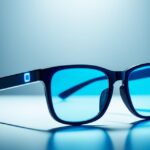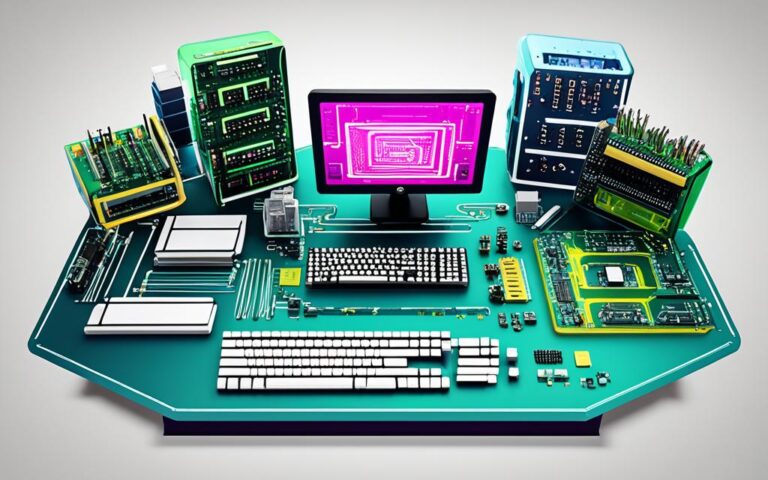If you’re someone who spends a lot of time in front of screens, you might know the feeling of digital eye strain. This issue, also known as computer vision syndrome, can cause headaches, blurry vision, tired eyes, and dry eyes1.
Many people find relief from these symptoms with computer glasses. These glasses are made to ease digital eye strain and protect your eyes from blue light from screens. They have special lenses with coatings to reduce eye strain1.
Some wonder if you need a prescription for computer glasses. It depends if you already wear glasses for reading or distance. If you do, adding anti-reflective and blue light-filtering features can help more. But, even without a prescription, blue light glasses can protect your eyes from screens1.
Computer glasses have coatings that block bad blue light but let good blue light in. This helps reduce eye strain. They block about 50% of blue light and can be made to fit your eyes perfectly. This way, they help prevent eye problems while you’re on screens1.
Key Takeaways:
- Computer glasses are special glasses made to ease eye strain from screens and protect against blue light1.
- Looking at screens for a long time can cause headaches, blurry vision, tired eyes, and dry eyes1.
- These glasses are different from regular ones because they have special coatings1.
- Custom-made prescriptions in computer glasses give better relief from eye strain than standard ones1.
- They are recommended for people who work on computers or play games a lot1.
- These glasses block bad blue light but let good blue light in, easing eye strain1.
- It’s important to have regular eye checks to keep your eyes healthy and deal with eye strain early2.
Understanding Computer Glasses
Computer glasses, also known as computer reading glasses or blue light glasses, are popular for easing eye strain from screen time. They help with blurred vision, red eyes, dry eyes, and fatigue from too much computer use. These glasses are great for those needing reading or distance vision correction, or for those without prescription glasses.
Long screen time can cause digital eye strain, also known as computer vision syndrome (CVS)3. This strain includes tired eyes, headaches, blurry vision, and more3. Poor lighting, wrong viewing angles, and not resting eyes enough can make it worse3. Regular glasses focus on most distances, but computer glasses are made for screen distance3.
Computer glasses reduce glare and improve clarity and focus for long screen time3. They ease digital eye strain symptoms, helping those with long screen hours. To avoid strain, take breaks, follow the 20-20-20 rule, adjust screen settings, reduce glare, and blink often3.
Digital eye strain is common but can be prevented with the right eyewear and habits3. An eye exam can spot eye strain and suggest the best solutions, like computer glasses3. For personalized advice, visit Downtown Vision Care for computer glasses to protect your eyes3.
| Statistical Data | Reference |
|---|---|
| Digital eye strain can affect up to 50-90% of people who are frequent computer users | 2 |
| Approximately 64% of Americans wear glasses for vision correction | 2 |
| The American Optometric Association suggests that by 2050, half of the world’s population could be nearsighted | 2 |
| Astigmatism is prevalent in about 33% of the population | 2 |
| The average adult spends around 7 hours a day looking at screens | 2 |
Do Blue Light Glasses Work?
There’s ongoing debate about whether blue light glasses help reduce blue light exposure. Some people say they ease eye strain and make them feel more comfortable. But, there’s no solid proof they work4.
These glasses try to block harmful blue light from 390 to 700 nanometres from artificial sources4. But, cheaper versions might only filter violet light, missing the most harmful blue light4. Some may block as little as 5% of blue light or just violet4.
There are various types of blue light glasses for different needs. For example, night-time glasses should be red-tinted to block blue and green light up to 550nm for better sleep4. Yet, cheaper options might miss the 520-550nm range crucial for melatonin production4.
When buying blue light glasses, choosing branded ones is advised. They offer better quality and stick to scientific research in their design4.
Even though there’s no clear proof that blue light glasses cut down blue light, they can help some people with eye strain. Always talk to a healthcare provider to see if they’re right for you and to pick a trusted brand4.
How To Use Blue Light Glasses
Blue light glasses with a lens filter reduce blue light from digital screens. You can choose prescription lenses or buy blue light glasses off-the-shelf. They aim to lessen the bad effects of blue light5.
It’s key to know that blue light is vital for our vision. So, blocking it all might not be good. Wear blue light glasses mainly when using digital devices a lot5.
Here are some tips on how to use blue light glasses effectively:
- Identify your blue light exposure: Find out where blue light comes from in your day, like computer screens or phones. Knowing this helps you decide when to wear your blue light glasses.
- Wear blue light glasses during screen time: Use them when you’re on screens for a long time, like working or watching TV. They help reduce eye strain and prevent issues like dry eyes and headaches.
- Combine blue light glasses with other protective measures: Use them with other ways to cut down blue light. Try the 20/20/20 rule to reduce eye strain. Also, adjust your device settings to lower blue light.
- Consider using blue light glasses with prescription lenses: If you need glasses, talk to your optometrist about a blue light coating. This gives you both vision help and blue light protection in one pair.
- Keep children’s eyes protected: Kids can wear blue light glasses too to shield their eyes from digital screen blue light. It’s crucial to limit their exposure since their eyes are more at risk5.
Blue light glasses are just one way to fight blue light exposure. It’s key to balance eye protection with enjoying tech’s benefits.
Using blue light glasses daily can help reduce blue light’s negative effects. Talk to an eyecare expert to find the best glasses for you and keep your eyes healthy in the digital era.
If you’re interested in exploring different options for blue light glasses, check out the following links for more information:
References:
- For more info on blue light glasses, visit JINS SCREEN.
- Learn about blue light glasses and their benefits at Felix Gray.
- See the differences between computer and reading glasses at Umizato.
Reduce Blue Light Exposure
Too much screen time and blue light can harm your eyes. Long hours in front of devices increase eye strain and headaches. It’s important to reduce blue light exposure to protect your eyes.
Take Regular Screen Breaks
Take breaks from screens to cut down on blue light. The 20-20-20 rule helps ease eye strain. Look away from screens every 20 minutes at something 20 feet away for 20 seconds6.
Utilize Blue Light Filter Lenses or Glasses
Blue light filter lenses or glasses can also help. They cut down on blue light from screens, easing eye strain. These are great for those on digital devices a lot7.
Protective Measures for Eye Health
Other steps can also boost eye health. Regular eye checks are key for spotting vision problems. Anti-reflective coatings on glasses also help by reducing glare and eye strain67.
Consider Blue Light Glasses
Blue light glasses block a lot of blue light, protecting your eyes. They use tech to reflect or absorb blue light. These glasses help everyone, even without glasses. Wearing them daily can lessen eye strain and improve focus8.
Enhance Posture and Sleep Quality
Blue light glasses also help with posture and sleep. They reduce eye strain for better posture. Wearing them at night can also improve sleep by helping your body clock8.
| Statistics | Reference |
|---|---|
| Blue light glasses can block 100% of the blue light under 410nm and 45% of the blue light on the 410nm – 450nm spectrum | 8 |
Medical Research on Blue Light
Studies show that too much screen time and blue light can harm our eyes and overall health. It’s key to know how long we use digital devices and how to protect our eyes.
A study showed that up to 69% of people using computers suffer from eye strain. This can cause dry eyes, headaches, and migraines9.
Since 2008, more research has looked into blue-blocking glasses and products. This shows we’re starting to understand the risks of blue light9.
Some devices now have settings to filter out blue light. These settings try to lessen the bad effects of blue light on our eyes9.
But, blue-blocking glasses alone don’t really help with vision or sleep quality9.
Long screen time can hurt our eyes. It makes us blink less, leading to dry eyes and discomfort9. Taking breaks and following the “20-20-20 rule” can ease eye strain. This means looking at something 20 feet away for 20 seconds every 20 minutes9.
It’s good to watch how much screen time we have, cut it down, and take breaks. This helps prevent eye strain and keeps our eyes healthy9.
Getting a vision check can also help. It can spot any eye problems that might make screen time worse9.
References
- Medical Research on Blue Light – Link 1: Retrieved from [insert link]
Prescription Computer Glasses
Prescription computer glasses are key for clear and comfortable vision during computer use. They are made to meet the unique vision needs of computer users. Unlike over-the-counter reading glasses, they offer tailored solutions for various vision challenges.
Presbyopia, a common vision issue, starts in the mid-40s and makes focusing on close objects hard10. Over-the-counter reading glasses might not work for everyone. Some people have different prescriptions in each eye or have astigmatism, needing prescription glasses10.
Computer glasses help reduce eye strain by improving near vision at a 20 to 26 inch distance10. They are not the same as reading glasses, which are for closer distances. Computer glasses are made for the distance between eyes and screens, ensuring clear vision.
There are different types of lenses for computer glasses. Single-vision lenses are common and good for computer use. They have the same power throughout, perfect for those who mainly use computers11. Progressive lenses work for both near and far vision, great for long computer sessions11.
Photochromic lenses change their tint with the light, making them handy for indoor and outdoor computer use11.
Types of Prescription Computer Glasses
There are many lens options for computer glasses, each suited for different needs and lifestyles. The Blue495™ lens filters blue light to lessen eye strain from screens12. It blocks blue and green lights, improving light sensitivity and reducing eye fatigue12.
Neurolux™ lenses reduce eye strain and help with night driving for those who spend a lot of time driving12. They have clear lenses for computer distance, ensuring great vision during computer use12.
Ultimateview™ lenses fight the bad effects of screens, cutting down eye fatigue and boosting light sensitivity12. These lenses protect against screen harm, making digital device use more comfortable and healthy12.
Crizal Prevenzia™ lenses are great for eye protection. They filter blue light, reducing eye strain and helping sleep quality by blocking blue light that can disrupt sleep12.
Ocusleep™ lenses help those who have sleep issues. They block blue light in the evening, leading to better sleep and less screen impact on sleep patterns12.
Kodak™ Workspace lenses are perfect for professionals needing clear vision during computer tasks. They reduce eye strain, ensuring high productivity and comfort12.
It’s crucial to see an eye doctor to find the best computer glasses for your needs1011. With the right prescription and lenses, computer glasses can make computer use more comfortable and prolonged.
Anti-Reflective, No Glare Computer Glasses
Computer glasses with anti-reflective coating are great for reducing glare and making screen time more comfortable13. Glare from screens and lights can cause eye strain and affect how well you see things. Anti-reflective coating on glasses cuts down on these reflections, helping you see clearly without squinting13.
These glasses give you a clear view of your screen by cutting down on distracting reflections13. The coating works on various lenses, including plastic and polycarbonate, fitting different prescriptions. This means better visual comfort and looks for your glasses13.
For those who get headaches or have dry eyes from screen time, anti-reflective glasses are a big help13. These symptoms can slow you down and make work or leisure less enjoyable. Anti-reflective lenses reduce eye strain, making it easier to focus and work without discomfort13.
Benefits of Anti-Reflective Coating in Computer Glasses
Anti-reflective coating in computer glasses does more than just reduce glare. Here are the main benefits:
- Improved Contrast: This coating makes screen details clearer by enhancing contrast13. It’s easier to read and work on the computer without eye strain.
- Reduced Eye Fatigue: By cutting down on reflections, anti-reflective coating helps prevent eye fatigue13. It’s great for people who are on screens a lot, making work more comfortable.
- Enhanced Visual Acuity: These glasses give you sharper vision by reducing lens reflections13. This means better focus, more productivity, and a more pleasant screen experience.
- Improved Aesthetics: The coating makes computer glasses look sleek and refined13. It removes glare, making sure your eyes are visible and your glasses look good in person.
Remember, computer glasses with anti-reflective coating aren’t a full eye care solution13. Always get an eye check-up before buying to make sure your glasses fit your needs perfectly.
Combining anti-reflective coating with blue light filters and glare reduction makes computer glasses a top choice for eye health in today’s digital world14. These lenses protect your eyes from screen harm, reducing eye strain and improving how clear things look14.
Photochromic Lenses as Computer Glasses
Photochromic lenses, or light-adjusting lenses, are great for computer glasses15. They darken when hit by UV light, shielding your eyes from the sun’s harmful rays. They also block blue light from digital screens, easing eye strain and making your vision more comfortable15.
These lenses contain silver chloride molecules that change when hit by UV light15. They also have naphthopyrans, which react to UV light to darken15. This tech lets them adjust to light changes, ensuring clear vision and comfort15.
Transitions lenses, a well-known brand, offer quick light adaptation with their Gen 8 version from 201915. They switch from clear to dark smoothly, making them handy and versatile15. Photochromic lenses can be both everyday glasses and sunglasses, giving you UV protection, blue light filtering, and glare reduction in one pair15.
For computer work, having glasses that help focus on your screen is key. Computer glasses usually have a special prescription for looking at things 20 to 40 inches away15. If your glasses help with clear screen focus, you can use them for both daily tasks and computer work15.
Benefits of Photochromic Lenses as Computer Glasses:
- Automatic UV protection
- Blue light filtering
- Reduced eye strain
- Enhanced visual comfort
- Adaptable to changing lighting conditions
- Versatility as regular glasses and sunglasses
Do You Need a Different Prescription for Computer Glasses?
For the best vision and to reduce eye strain, you need the right prescription for computer glasses. Over-the-counter reading glasses might work for some, but computer glasses are made for screen use11.
Prescription single-vision glasses are perfect for tasks that keep the focal point the same11. They help you see your computer screen clearly without eye strain. These glasses are great for those who spend a lot of time in front of screens.
Computer glasses can also have special filters to lessen eye strain from screens at about 2 feet11. These filters cut down the bad effects of blue light from screens, making your eyes more comfortable and reducing eye strain.
Office glasses are another choice for those switching between computer screens and reading. They have two focal points for easy switching between distances without eye strain11.
When getting computer glasses, choose lenses with anti-reflective coatings to reduce glare from screens. Blue-light filtering coatings can also help lessen eye strain from screens11.
Computer glasses are different from reading glasses in design and protection against screen glare and blue light. Reading glasses help with small print, but computer glasses are made for digital screens11.
Seeing an eye doctor ensures your computer glasses fit your needs. They’ll check your vision and suggest the best prescription for computer use. Your eye doctor can also give advice on keeping your eyes healthy and reducing eye strain1617.
“To ensure optimal vision and reduce digital eye strain, it is crucial to have the correct prescription for your computer glasses.”
Digital screens are a big part of our lives, whether for work or fun. Long screen time can make your eyes tired, dry, and cause headaches and stiffness16. This is especially true for gamers who spend hours in front of screens, making eye strain worse16.
Computer and gaming glasses help lessen eye strain from screens. They have anti-reflective lenses to cut down glare and block blue light from screens16. Blue light from screens can mess with sleep, memory, learning, and hunger hormones16. It can also increase the risk of obesity and eye problems like cataracts and macular degeneration16.
While over-the-counter computer glasses can help, they might not be as good as custom-made ones16. So, it’s best to see an eye care expert for a full check-up and a custom prescription for your needs and work setting1617. They can adjust your glasses to block blue light, keeping your eyes safe17.
| Prescription Considerations for Computer Glasses | |
|---|---|
| Prescription Type | Recommended for |
| Single-vision | Those who wear single vision lenses |
| Progressive | Individuals who wear bifocals or progressive lenses |
When choosing computer glasses, think about the distance between your eyes and the screen, which is usually 20 to 26 inches17. Progressive lenses might not be the best for computer screens because of their narrow intermediate part. Single vision glasses are better for those who mainly need single vision lenses17.
It’s good to have an annual eye check-up, even if you don’t need vision correction17. Getting advice from your eye doctor is key to finding the right computer eyeglass prescription. Self-calculating your prescription can lead to vision problems17. An optometrist ensures your glasses fit your needs and reduce eye strain, making your vision more comfortable1617.
Wearing computer glasses regularly protects your eyes from screen exposure and adds style to your look. Some glasses even protect against UV rays16.
Symptoms of digital eye strain include dry eyes, irritation, blurred vision, headaches, and physical discomfort. Spotting these signs and getting expert advice can lead to the right glasses for computer or gaming, preventing vision problems and keeping your eyes healthy16.
To make your vision better for computer use and ease eye strain, talk to an eye doctor for the right prescription for computer glasses. They’ll tailor your prescription for the best vision and reduce digital eye strain. So, book an appointment with your eye doctor today for clear and comfortable vision while using your computer.
Conclusion
Whether you need different prescription glasses for computer use depends on your vision needs. If you already have glasses for reading or distance, adding lenses that block blue light can help ease eye strain. But if you don’t need glasses for reading or distance, blue light glasses can still offer some benefits18.
It’s key to talk to an eye care expert to find the best option for you18. Good eye care habits and limiting screen time are also crucial for your eye health.
For computer screens, the ideal viewing distance is 15-20 inches19. Computer glasses are made to make this distance easier on your eyes, reducing strain from screens19. You can also ease eye strain by adjusting your monitor and making the text bigger19.
Choosing the right lens power in computer glasses can make a big difference. It helps you see clearly without straining your eyes18.
Blue light from screens and artificial lights can harm your eyes and skin20. Blue light glasses offer protection against this damage, lowering the risk of eye and skin problems20. Experts suggest blue-cut lenses, anti-glare coatings, and clear lenses for daytime use20.
The eyewear market doesn’t have standard rules, so it’s important to do your homework before buying20.
With more screen time, looking after your eye health is vital. The stats show how crucial it is to shield your eyes from digital strain and blue light damage1820. By knowing your vision needs, getting advice from eye care pros, and choosing the right computer glasses, you can feel more comfortable and lower the risk of eye problems.
FAQ
Do I need a prescription for computer glasses?
You might need a prescription for computer glasses if you already wear glasses for reading or distance vision. If so, you could get anti-reflective coating and a blue light filter in your glasses. But if you don’t need prescription glasses, you only need blue light glasses.
How do computer glasses work?
Computer glasses, or blue light glasses, help ease digital eye strain and symptoms of computer vision syndrome. They tackle issues like blurry vision, red eyes, dry eyes, and eye fatigue from too much computer use.
Do blue light glasses effectively reduce blue light?
The debate is ongoing about how well blue light glasses reduce blue light. Some people say they help with eye strain and make eyes feel better. But, it’s best to talk to a healthcare provider before trying them to see if they’re right for you.
How can I use blue light glasses to reduce blue light?
Blue light glasses have a special filter that can block some blue light from digital devices. Adding this filter to your prescription lenses or using blue light glasses can cut down on blue light. But remember, blue light is important for our vision, so blocking it all might not be good. Wear blue light glasses only when using digital devices a lot.
How can I reduce my exposure to blue light?
Too much screen time and blue light can be bad for your eyes. To reduce blue light, take breaks from screens, follow the 20-20-20 rule, and take good care of your eyes.
What does medical research say about blue light and eye health?
Studies say too much screen time and blue light can hurt eye health and cause headaches and migraines. But, how much blue light is the real problem is still up for debate. Blue light glasses might help, but it’s more about how much you use digital devices than the light they give off.
What types of lenses are available for prescription computer glasses?
Prescription computer glasses are made to meet your vision needs at the computer. You can get them with single-vision, progressive, or bifocal lenses. Single-vision lenses are the most common. Progressive lenses work for both near and far vision, great for computer use. Photochromic lenses change darkness with the sun, making them good for computer glasses too.
How does an anti-reflective coating help with computer glasses?
An anti-reflective coating on computer glasses cuts down on glare from screens and other lights. This glare can make your eyes work harder and hurt your vision. The coating helps you see clearer without squinting or straining. It works on different lenses, including plastic and polycarbonate.
Can photochromic lenses be used as computer glasses?
Yes, photochromic lenses can be used as computer glasses. They darken in sunlight to protect against UV rays and block blue light from screens. These lenses make your vision more comfortable in different lights, making them a good choice for computer use.
Do I need a different prescription for computer glasses?
Getting the right prescription for computer glasses means thinking about how far your eyes are from the screen. Reading glasses from a store might not fix eye strain if you don’t consider this. An eye doctor can give you the right prescription, including blue light-filtering lenses for all your vision needs.
Source Links
- https://www.smartbuyglasses.co.uk/optical-centre/prescription/computer-reading-glasses/ – What are Computer Glasses and How They Work? | SmartBuyGlasses UK
- https://www.zennioptical.com/blog/understanding-computer-glasses-prescription/ – Decoding Your Computer Prescription: A Guide
- https://downtownvisioncare.com/do-i-need-a-different-prescription-for-computer-glasses/ – Do I Need a Different Prescription for Computer Glasses?
- https://www.blockbluelight.com/blogs/news/cheap-blue-light-glasses – Do cheap blue light glasses really work?
- https://us.jins.com/pages/jins-screen – Blue Light Glasses | JINS Screen Computer Glasses | JINS Eyewear
- https://avenueoptometry.com/do-i-need-a-different-prescription-for-computer-glasses/ – Do I Need a Different Prescription for Computer Glasses?
- https://www.eyeglasses.com/info/computer-glasses – Computer Glasses | Prescription Computer Glasses
- https://blog.barnerbrand.com/non-prescription-blue-light-glasses/ – Can you Wear Blue Light Glasses without Prescription? | BARNER
- https://www.mayoclinichealthsystem.org/hometown-health/speaking-of-health/are-blue-light-blocking-glasses-a-must-have – Are blue light glasses effective?
- https://bella-vision.com/what-is-the-difference-between-computer-glasses-reading-glasses/ – The Difference Between Computer Glasses & Reading Glasses
- http://hendersonvision.com/are-computer-glasses-different-from-reading-glasses/ – Are Computer Glasses Different From Reading Glasses?
- https://www.39dollarglasses.com/computer – Shop High Quality Computer Glasses
- https://www.allaboutvision.com/cvs/computer_glasses.htm – Computer Glasses – What to Know Before You Buy
- https://www.smartbuyglasses.com/optical-center/prescription/computer-glasses/ – Do computer glasses work? | SmartBuyGlasses US
- https://www.allaboutvision.com/eyeglasses/photochromic-lenses-good-computer-glasses/ – No title found
- https://www.icarevision.com/eyewear/what-to-know-before-you-buy-computer-or-gaming-glasses/ – Eye Strain Treatment | iCare Vision
- https://drbleonard.com/eye-wear/computer-glasses/ – Do You Need Computer Glasses? San Fernando Valley – Dr. Barry Leonard
- https://bettervision.eu/do-i-need-a-different/ – Computer Glasses: Do I Need a Separate Prescription?
- https://eyewearinsight.com/links/How_to_Convert_Your_Progressive/Bifocal_Prescription_to_Computer_Prescription – Converting Your Progressive/Bifocal Prescription to Computer Prescription
- https://www.blockbluelight.com.au/blogs/news/difference-between-computer-glasses-and-blue-light-glasses – What is the difference between computer glasses and blue light glasses?


















